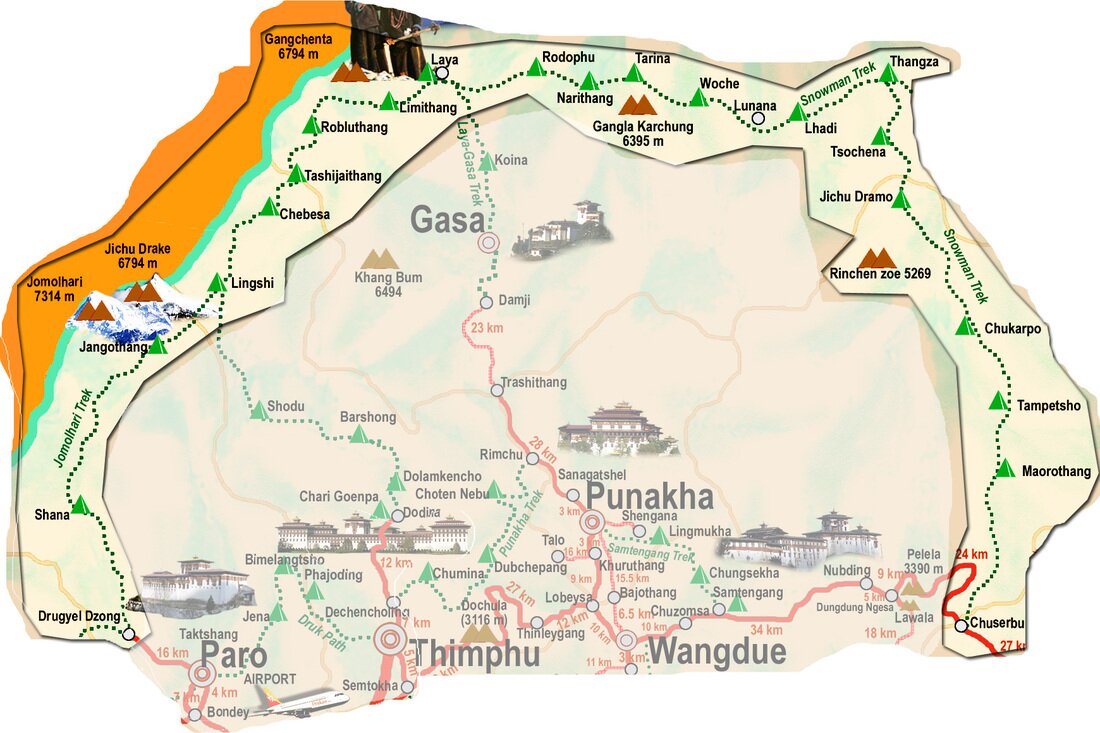"One of the Most Difficult Treks in the World" -Lonely Planet
Many groups that attempt this tough trek do not actually finish it due to problems with the high altitude or snow-blocked passes. Therefore, the best time for the Snowman Trek – unlike the other high-altitude treks of Bhutan – is in the summertime. Still, those who make it will remember this trek as outstandingly beautiful and maybe as the most rewarding trek of their life. Therefore, our writers and organizers of the route have prepared an interesting trip and a reliable route for you. These writers who described this trip work in a company and provide letter writing services at the highest level and know a lot of information about Bhutan and its places of interest.
Itinerary (+2 Days, Arrive and Depart)
Days 1-10: Either a modified route of the Jumolhari Trek or the Laya Gasa Trek
Day 11: Rest/Acclimatization day in Laya. If you have trekked from Drukgyel Dzong you should spend a day recuperating from the trek to Laya and preparing yourself for the rest of this challenging but spectacular trek. If you have started from Tashitang/Damji (Punakha) you should also walk up to Laya to acclimatize, and not just stay at the trail junction to Lunana. It’s worthwhile to spend one day in Laya just for the great views from Laya and its extroadinary inhabitants. Day 12: Laya – Rhoduphu (Distance 19km, six to eight hours, 1,030m ascent, 750m descent, camp altitude 4,160m). From Laya we descend to an army camp and continue following the river till the turn off point to Rhoduphu. After lunch the climb continues through rhododendron bushes till you reach the camp at Roduphu just next to the Rhodu Chhu. Day 13: Rhodophu – Narethang (Distance 17km, five to six hours, 740m ascent, camp altitude 4,900m). After following the river for about half an hour you will have a steady climb to a high open valley at 4,600m and then further up to Tsomo La (4,900m). Tsomo La offers a superb view of Lunana, Mount Jomolhari and Jichu Drake, and the Tibetan border. The route then crosses a flat, barren plateau at about 5,000m. The campsite at Narethang is towered by the peak of Gangla Karchung (6,395m). Day 14: Narethang – Tarina (Distance 18km, five to six hours, 270m ascent, 1,200m descent, camp altitude 3,970m). From the camp you will climb for about an hour to Gangla Karchung La (5,120m). The view from the pass is breathtaking and the whole range of mountains including Jekangphu Gang (7,100m), Tsenda Kang and Teri Gang (7,300m) can be seen. The pass descends along a large moraine. Again one has great views: a massive glacier descends from Teri Kang to a deep turquoise lake at its foot. Up here a glacial lake burst through its dam in the early 1960s, causing widespread damage and partially destroying Punakha Dzong. Finally, it is a very long descent through thick rhododendron to Tarina valley, where you will find several good campsites along the Tang Chhu. Day 15: Tarina – Woche (Distance 17km, six to seven hours, 270m ascent, 330m descent, camp altitude 3,910m). The walk leads down through conifer forests following the upper ridges of the Pho Chhu, passing some impressive waterfalls. The trail then climbs over a ridge and drops to Woche, a settlement of a few houses, the first village in the Lunana region. Day 16: Woche-Lhedi (Distance 17km, six to seven hours, 980m ascent, 1,190m descent, camp altitude 3,700m). The trek starts through juniper and fir forests, and further ahead, through rhododendron bushes. Climb up to Keche La pass (4,650m) where one can have the great view of surrounding mountains again. After the pass, descend to the riverside walking through a village with a stunning view of Table Mountain and others. Follow up the river till Lhedi Village. Lhedi has a basic health unit, a school and a wireless telephone connection. Day 17: Lhedi-Thanza (Distance 17km, seven to eight hours, 450m ascent, camp altitude 4,150m). In clear weather , you will have great views of Table Mountain (7,100m).Around lunchtime you will pass the small village of Chozo (4,090m) which has a dzong still in use. Reaching Thanza again you will have a great view of Table Mountain which forms a 3,000m high wall of snow and ice behind the village. Although there are possibilities to camp directly at Thanza, most groups prefer to camp in Thoencha. Day 18: Rest day at Thanza. In Thanza walk around and experience some village life or climb up the ridge for fascinating views of lakes and mountains. But as it takes time to arrange new yaks (the yaks from Laya will not go further than Thanza) you might have to spend one day at Thanza anyway. Day 19: Thanza – Danji (Distance 8km, three to four hours, 80m ascent, camp altitude 4,230m). From Thoencha, the trail climbs up to a large boulder from where you will have excellent views of Thanza, Toencha and Choso village and the surrounding mountains. After a few hours of relatively flat and easy walking, you will reach a yak meadow with some yak herders’ huts. An excellent campsite with a great chance to spot some blue sheep on the hills above. A trail junction near the campsite will give you the choice between the route up to Gangkhar Puensum base camp, and further on to Bumthang or to Sephu (Trongsa). Both routes are described in this website. Day 20: Danji – Tshochena (Distance 12km, five to six hours, 980m ascent, 240m descent, camp altitude 4,970m). Having chosen the route to Sephu, the trek crosses the creek and after a long climb, you will reach Jaze La (5,150m) with spectacular panoramic mountain views . The path then descends between snow covered peaks and a couple of small lakes to the campsite near the shore of Tshochena lake. Day 21: Tshochena – Jichu Dramo (Distance 14km, four to five hours, 230m ascent, 150m descent, camp altitude 5,050m). You follow the bank of the blue green lake before arriving at a ridge at 5,100m, where there is another spectacular view in all directions. After going up and down over small hills to reach a glacial lake, the route descends first before climbing again up the next pass, the Loju La (5,140m). Finally after crossing a small saddle (5,100m) you will enter a wide glacial valley from where the trail descends gradually to the campsite at Jichu Dramo. Day 22: Jichu Dramo – Chukarpo (Distance 18km, five to six hours, 320m ascent, 730m descent, camp altitude 4,600m). Right after leaving the camp you will climb through a moraine to Rinchen Zoe La (5,320m). Spectacular mountain scenery with Gangkhar Puensum amongst the impressive mountains is the reward for climbing the highest pass on this trek route. Rinchen Zoe Peak (5,650) towers above the pass the west. Descending from the pass, the route leads into a wide valley with several lakes and goes steeply down along a moraine to the Thamphe Chhu. Here the vegetation begins to thicken again and you will see the first real trees since Lhedi. After a couple of hours you reach the campsite at Chukarpo. Day 23: Chukarpo – Thampe Tsho (Distance 18km, five to six hours, 400m ascent, 700m descent, camp altitude 4,300m) The descent continues along the river till you reach the yak herder huts at Gala Pang Chhu (4010m). From here the trail climbs steeply towards Thampe Tsho, a beautiful clear turquoise lake, with the campsite next to it. Day 24: Thampe Tsho – Maurothang (Distance 14km, five hours, 330m ascent, 1020m descent, camp altitude 3,610m). From the lake you climb steeply to the last pass on your trek, the Thampe La (4,600m) with a good chance to spot some blue sheep on the way. Then the path descends to the sacred lake Om Thso. Passing a waterfall you will reach another, smaller lake 100m below to descend steeply to the Nikka Chhu. The path finally leads through mixed forest to large clearing on the banks of the river with a few yak herder huts, Maurothang. Day 25: Maurothang – Sephu (Distance 18km, five to six hours, 990m descent). On the last day of this extraordinary trek your porters will have to change from yaks to horses as the yaks will not be willing to go further down. The path follows the Nikka Chhu to reach a large grassy area overlooking the road and the village of Sephu. You finally reach the road at the Nikka Chhu bridge at Sephu where you will find several stores (mainly selling bamboo products) and small restaurants. |
Fare Breakdown
|




